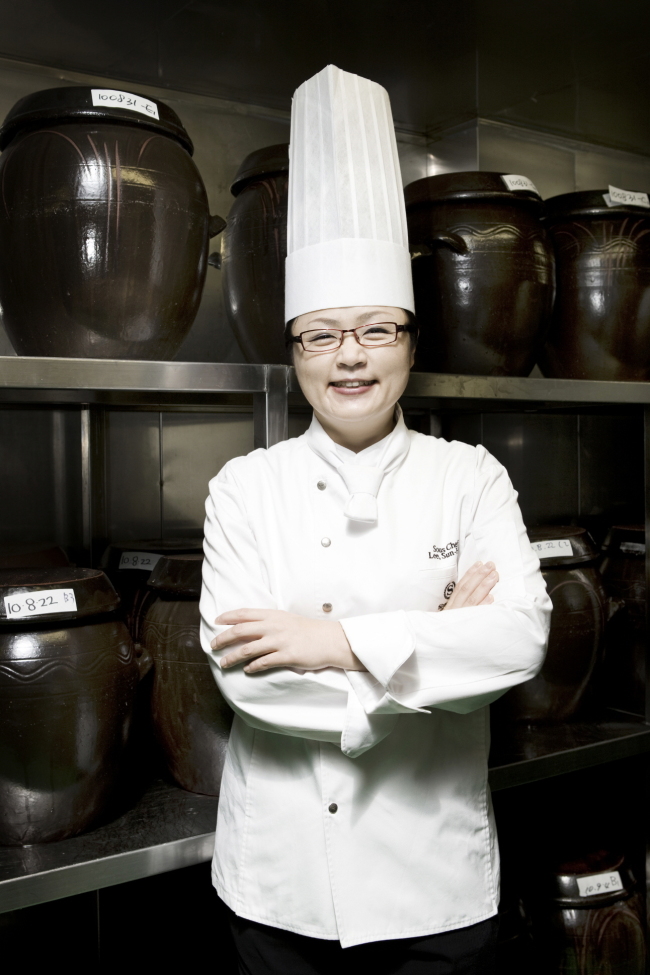[Herald Interview] The science and art of kimchi
Kimchi master Lee shares secret of her pickled, fermented cabbage
By 이우영Published : Nov. 20, 2015 - 18:02
For Lee Sun-hee, the sous chef at the Sheraton Grande Walkerhill Hotel, making Korea’s favorite side dish, kimchi, is all about science and art.
She uses statistical data and historical documents that recorded the cooking techniques of dishes served for Joseon Dynasty royalty to sustain the traditional taste of the hotel’s kimchi.
Lee has been making kimchi at the hotel for nearly two decades. Not only does she continuously search for academic papers for new culinary insights, but actually wrote a thesis to provide data proving that her own kimchi was more nutritious than kimchi made at corporate factories and sold commercially.

“This is because we use brisket broth and freshwater shrimps as main ingredients along with salt and pears to make and ferment kimchi,” Lee, 45, told the Korea Herald at the hotel in Gwangjin-gu, Seoul.
Her data showed that brisket broth can add proteins and vitamins, while freshwater shrimp can boost calcium, the sous chef said, noting that most others use salted shrimp to make the spicy side dish. This makes a big difference between Walkerhill’s “SUPEX Kimchi” brand and other kimchi, she said.
The hotel also uses pears instead of sugar to create the “sweetness” of kimchi. This helps create lactobacillus in the fermentation process, while getting rid of bad bacteria.
“That is why kimchi is a healthy food. Data shows that our kimchi has about 20 times more lactobacillus than yogurt,” said Lee.
“Kimchi is especially good for dieting.”
Lee’s kimchi has been dubbed “President’s Kimchi,” as the hotel has been providing kimchi for most presidential events at Cheong Wa Dae over the years.

She prepared and served kimchi stored in large terra-cotta pots at dinner events of the inter-Korean summit between late South Korean President Roh Moo-hyun and late North Korean leader Kim Jong-il in Pyongyang in October 2007.
People then and even now still ask why she insists on using pots to mature and store kimchi as they are not only heavy but also easily breakable.
This is also because of the data, she said, which showed that pots can extract “bad gas” and help maintain kimchi’s traditional taste, compared with kimchi in stainless steel or plastic storage products.
“Pots enable you to create kimchi with the best traditional taste,” Lee said.
“When that gas is removed, pots keep kimchi’s texture and carbonic acid alive. Thus, we call this ‘living and breathing kimchi.’”
She stressed that people should also appreciate the beauty of the side dish.
“You cannot cut kimchi with scissors. It must be handled neatly and laid beautifully on a plate for people to enjoy eating it,” she said.
It was not all easy for Lee, who began her culinary career making Western dishes at the hotel, to come this far in creating and sustaining the taste of kimchi.
After her senior chefs retired and Lee was left in charge of the hotel’s kimchi, people started to say that the taste had changed.
“It was very difficult in my first year to rediscover that special taste created by my senior chefs.”
So, she had to go back to basics -- reading documents and books, analyzing data and reviewing the knowledge passed down by her senior chefs on kimchi and its raw ingredients.
Her next goal is to create tasty kimchi that can be enjoyed by low and mid-income families.
“I can find and get locally grown quality materials which are less expensive than those used for SUPEX Kimchi, and make it for everyone,” she said.
By Park Hyong-ki (hkp@heraldcorp.com)









![[Kim Seong-kon] Democracy and the future of South Korea](http://res.heraldm.com/phpwas/restmb_idxmake.php?idx=644&simg=/content/image/2024/04/16/20240416050802_0.jpg&u=)







![[KH Explains] Hyundai's full hybrid edge to pay off amid slow transition to pure EVs](http://res.heraldm.com/phpwas/restmb_idxmake.php?idx=652&simg=/content/image/2024/04/18/20240418050645_0.jpg&u=20240418181020)

![[Today’s K-pop] Zico drops snippet of collaboration with Jennie](http://res.heraldm.com/phpwas/restmb_idxmake.php?idx=642&simg=/content/image/2024/04/18/20240418050702_0.jpg&u=)